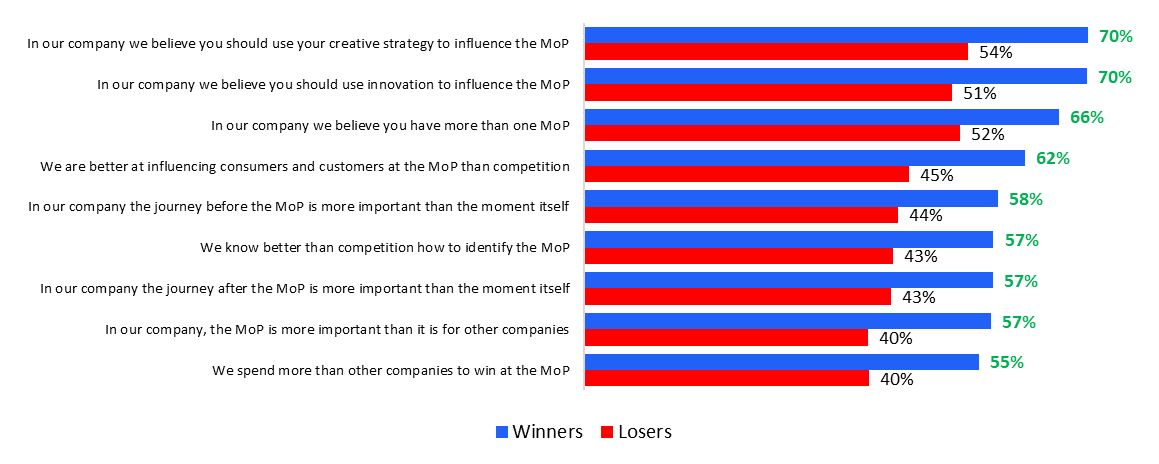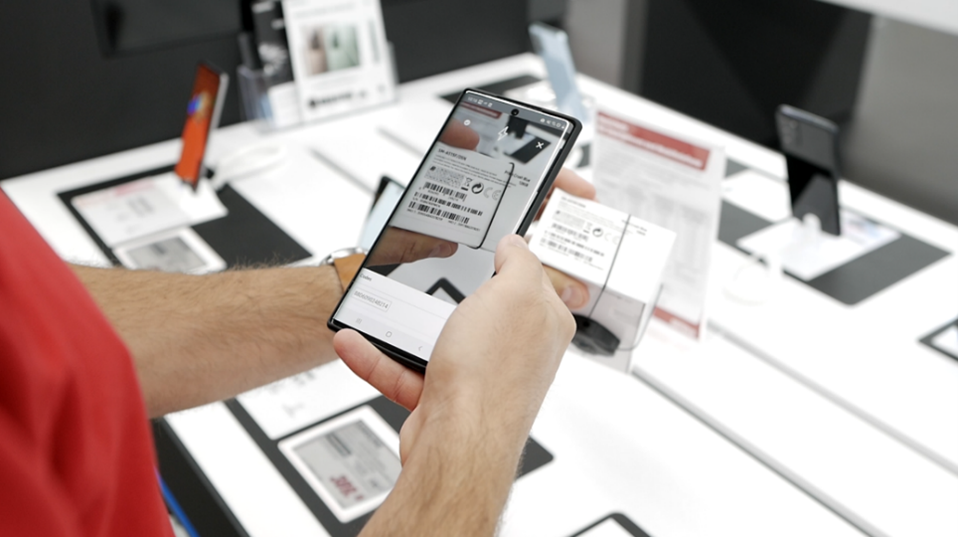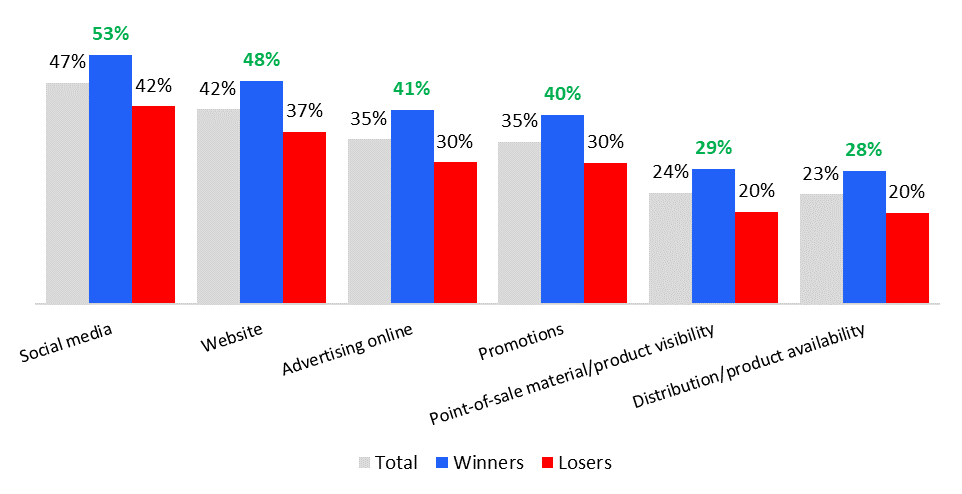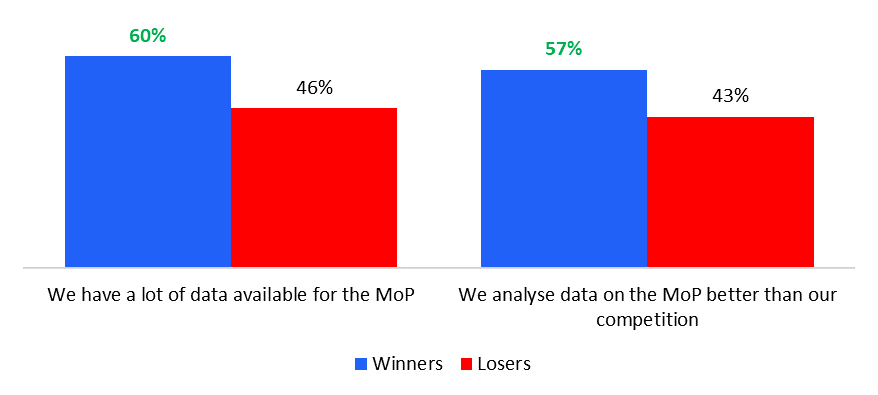How to win at the moment of purchase
Gepubliceerd op 13 06 2022On May 31st, our Brand Growth Event took place showcasing interesting and inspiring presentations from science (EDHEC Business School), practice (MediaMarktSaturn and TENZING) and marketing research (us). All presentations captured aspects of the Moment of Truth and were complementary to each other. In this article, we will dive into some of the results from our Brand Growth study among more than 2,300 European marketers. Thereby linking those results to what we have picked up from the presentations.
Knowing your moment of truth
We already learned that it is important that firms define their Moment(s) of Truth (MoT). We have seen that this clearly helps put focus and know where to go and that it also pays off. Companies that have defined a MoT are much more successful. This is also something that became apparent from the presentation by Arne De Keyser from EDHEC Business School. He explained his framework on customer experience where the MoT fits in and mentioned that it is all about the TCQ: Touchpoints, Contexts, and Qualities. These can be used to help define a MoT and enable you to audit your organisation on how well it performs on the MoT. To implement this, you should know well what the different touchpoints are (e.g., pre- or after-purchase and brand-controlled or non-brand controlled), the context you are in (e.g., emotional, or cognitive factors and market conditions) and what the quality of your products/services is and how interacting with your company affects consumers. Arne explained that firms that can identify their TCQ very well – and thus have a clear definition of the MoT – know what they can do to delight customers, which consequently has a positive impact on business revenues.
Now, we observed in our annual interviews with CMOs, marketing directors and CMIs that the majority of firms defined their MoT to be the Moment of Purchase (MoP). For example, “There are many things that precede the Moment of Truth, but ultimately, it is about consumers buying your product.” (VSM) or “The moment we sell something and in which way”, “The moment of truth is when you are about to sign the big deal”. Therefore, the rest of this article focuses on the Moment of Purchase (MoP).
How to influence the Moment of Purchase?
For every brand or product, there is a decisive moment for whether the product or service is purchased. From the many interviews DVJ Insights has each year, it becomes clear how important this moment is and how much effort is needed to be effective in this decisive moment and win the customer. So, what are marketers doing to influence this Moment of Purchase? What works and what doesn’t? To examine this, we will look at the differences between winners and losers in our data. To be clear, winners are those companies that can increase revenue, whereas losers are those companies that saw revenues remain stable or decline.
Interestingly, marketers believe that creative strategy and innovation should be used to influence the Moment of Purchase. Especially winning companies believe this more than losing companies. And we have seen that winning companies perform better on the Moment of Purchase than the competition, namely 28%-points better! Also, winners believe that they are better at influencing consumers and customers at the Moment of Purchase than the competition (+17%-point). So, what are they doing differently? Let us illustrate with some examples from our Brand Growth Event.

Figure 1 Top 2 scores on MoP statements for winners vs losers
How to use innovation to win at the mop?
The presentation of Henny Steiniger from MediaMarktSaturn focused very much on innovation and how you can use this to delight customers in-store as well as online, which are both where customers eventually buy. To define where they want to focus on with their innovations, they use a customer journey blueprint, which is very much related to Arne’s TCQ framework for auditing. At MediaMarktSaturn, they developed and implemented the MyStore app (see Figure 2) for employees, enabling them to consult customers better, standing in front of products and not moving to a PC desk far away. This way, employees can better and quicker tell customers what the availability of a product is, check pricing at the competition, compare products, and highlight differences. Another example is how to deal with the fact that customers sometimes must wait in store, for example for seeing a sales consultant or waiting for a repair to be ready. Waiting is inevitable, but you can do something about how it is perceived! Therefore, MediaMarktSaturn introduced the digital queue (which sounds better in German by the way: “Die digitale Kundenwarteschlange”). Only introduced in a few German stores yet (for a global roll-out later), customers are put in a digital queue, enabling them to do something else (like walking through the store, trying out different products) while waiting. When it is their turn, they get a signal. Pilots showed that this is improving customer satisfaction. And we guess that consumers may decide to also buy additional products.

Figure 2 MyStore app from MediaMarktSaturn
How to use your creative strategy to win at the mop?
Let us turn to another example, the one from TENZING, an all-natural energy drink. As founder Huib van Bockel explains: This drink aims to disrupt the world of energy drinks and wants to create a strong emotional connection between its customers and the brand. Its mission is to create plant-based energy drinks that are big on energy and low on impact. They realise this first by being carbon negative, but also by cleaning up Mount Everest and adding value in other ways to different sports communities. For example, TENZING developed a clean air tracking app for runners to be able to track the air cleanliness (the clean air run club). Of course, this is an innovation, but here we would like to focus on the creative strategy behind it. By launching this app in a runner community, they got attention around the brand and lots of attention in the press. It was named the number 1 app that will change your life by Men’s Health, and runners also started to communicate about the app on social channels. Because if it is of value to people, they will share it. So, their creative strategy is highly aligned with their mission and clearly resonates among their communities.
Figure 3 Attention on social media for the TENZING clean air tracker
Which marketing activities to use at the mop?
Let us go back to some of the results of our European Brand Growth Study. Winners indicated that they spend more than the competition to win at the MoP (+15%-points, see Figure 1). But where do they spend it? Already touched upon in the examples from practice, which activities are best to use at the Moment of Purchase? Winners focus their activities, much more than losers, on social media, the website and advertising online (+11%-points). Tools that TENZING is clearly using in their creative strategy. Additionally, if you want to win at the MoP you should focus on your products/services by using promotions, POS material, and your product availability. This sound obvious but it helps to know from data instead of a gut feeling. This is something MediaMarktSaturn is focusing on to a large extent, especially with the MyStore app. In Figure 4 the largest differences in utilising marketing activities are presented. We do not observe any differences between winners and losers in utilising e-mail and advertising offline, and only a minor difference for SEA/SEO.

Figure 4 Marketing activities on MoP
Does using data help to win at the mop?
Finally, we asked marketers about the extent to which they use data on the MoP. We observe that data utilisation is also a distinguishing point between winners and losers. First, winners indicate that they have more data available on the MoP and second, can better analyse these data than the competition. Data that is being used most often are sales data, followed by social media data, online reviews/ratings, survey data, and online tracking data. Sales data sounds obvious on the MoP, but social media data being mentioned second is interesting. Maybe this is because a lot can be learned on social about customers, other than sales information, and we saw that social media is being used a lot to influence consumers at the MoP. We again observe significant differences between winners and losers in the sense that winners use data more than losers. The differences are largest for sales, social media, and online tracking data.
To be able to successfully use data on the MoP it is important to prioritise and time well. Also, the missing link between analysts and decision-makers is mentioned often. Of course, it is not the most difficult part to get the data, but subsequently what you do with it. Interestingly, winners report experiencing more challenges in using data on the MoP than losers. This might be because winners use more data than losers.

Figure 5 Data utilisation on the MoP
winning at the mop
To summarise, it is first of utmost importance to know your Moment(s) of Truth. As a help for defining and subsequently auditing the MoT, the TCQ nomenclature might very well be used (De Keyser et al., 2020). To influence the MoP, you should use innovation and creative strategy, which is illustrated by examples from MediaMarktSaturn and TENZING. Second, we looked at which marketing activities can best be used to win at the MoP; they are online media, such as social, the website and online ads, as well as focusing on the product/service with promotions, POS material and product availability. Finally, using data on the MoP can also help to win. It is then crucial to know how to prioritise and which insights to attract from it.
In general, a lot can be learned from companies that are doing well. They have a clear positioning and know what their customers want.
Interested in more insights and learnings from this year’s European Brand Growth Study? Download the report for free!